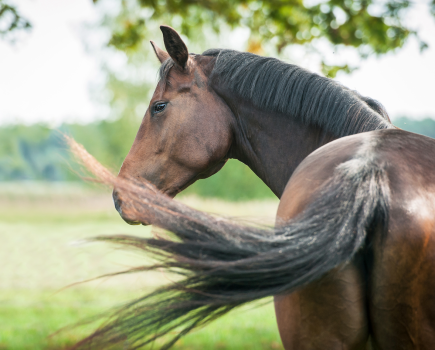A horse’s whiskers, or vibrissae, are sensory hairs that provide valuable information. They are longer, stiffer and thicker than ordinary coat hair and each whisker has its own blood supply.
Whiskers are also super sensitive due to the densely packed nerves at their root, which send sensory messages to the somatosensory cortex in the horse’s brain.
Horses have sensory vibrissae on their muzzles — around their nostrils, mouth and chin — as well as around their eyes on both their upper and lower eyelids.
A horse’s whiskers help him navigate his world. Indeed, they’re so sensitive to vibration and changes in air current they can instantly inform the horse about his environment; helping him avoid injury by detecting nearby objects, differentiating between textures, judging wind direction and identifying food.
How do horses use their whiskers?
Horses have a very mobile top lip, which means they can grasp and manipulate objects using their mouth. This is similar to the human hand in terms of nerve ending and dexterity.
In short, they use their whiskers to help guide their lips through touch. Whiskers help newborn foals find their dam’s teats, and adult horses use them to judge the distance of objects from their face.
Many horse owners will have seen their horse test whether the electric fence is on by holding the tips of their whiskers next to the tape.
Although there is a lack of research into the function of vibrissae, they may also play a role in how horses communicate with each other, and could compensate for reduced vision or blindness.
Horses have a blind spot beneath their muzzle and so their whiskers are a vital aid to their vision. Some believe the vibrissae act as a ‘third eye’, giving the horse a sense of their surroundings.
Is it OK to remove whiskers?
Whisker removal is a contentious issue that divides the equine community. Some horse owners believe the whiskers on a horse’s muzzle and around their eyes look untidy; others see their removal as cruel and unnecessary.
In the UK there is a long-standing tradition of removing whiskers for some showing classes. However, many competitors have reported on social media that they don’t trim their horses and that this hasn’t prevented them from winning or being placed in classes.
It is vital to remember that whiskers are critical to a horse’s spatial awareness; removing them reduces their knowledge of the environment and therefore leaves them partially handicapped. This could affect their behaviour and compromise horse and rider, or handler, safety.
Horses are more likely to suffer from facial injuries if their whiskers are trimmed or removed, as they have no means of judging the distance to objects immediately in front of their eyes or below their muzzle.
A horse’s whiskers are there for a number of reasons, and in the interests of welfare we should leave them alone if we want the best for them.
Competition rules
A number of international equestrian organisations have banned the trimming of a horse’s whiskers. Since 1st July 2021, horses are prohibited from competing in any FEI competitions internationally if their “sensory hairs have been clipped and/or shaven or in any other way removed”.
This ban includes both the sensory whiskers on the horse’s muzzle and those around the eyes. The ruling exempts trimming for veterinary reasons.
This FEI ban is the latest in a long list of international restrictions on this matter. The trimming of a horse’s whiskers has been banned for years in Germany and Switzerland under animal welfare legislation.
In 2019, the French Equestrian Federation banned the trimming of whiskers for horses and ponies competing at their endorsed events.
Equestrian Sports New Zealand and the New Zealand Pony Club Association have also banned the trimming of whiskers and inner ear hair of horses and ponies taking part in any of their events and activities.









